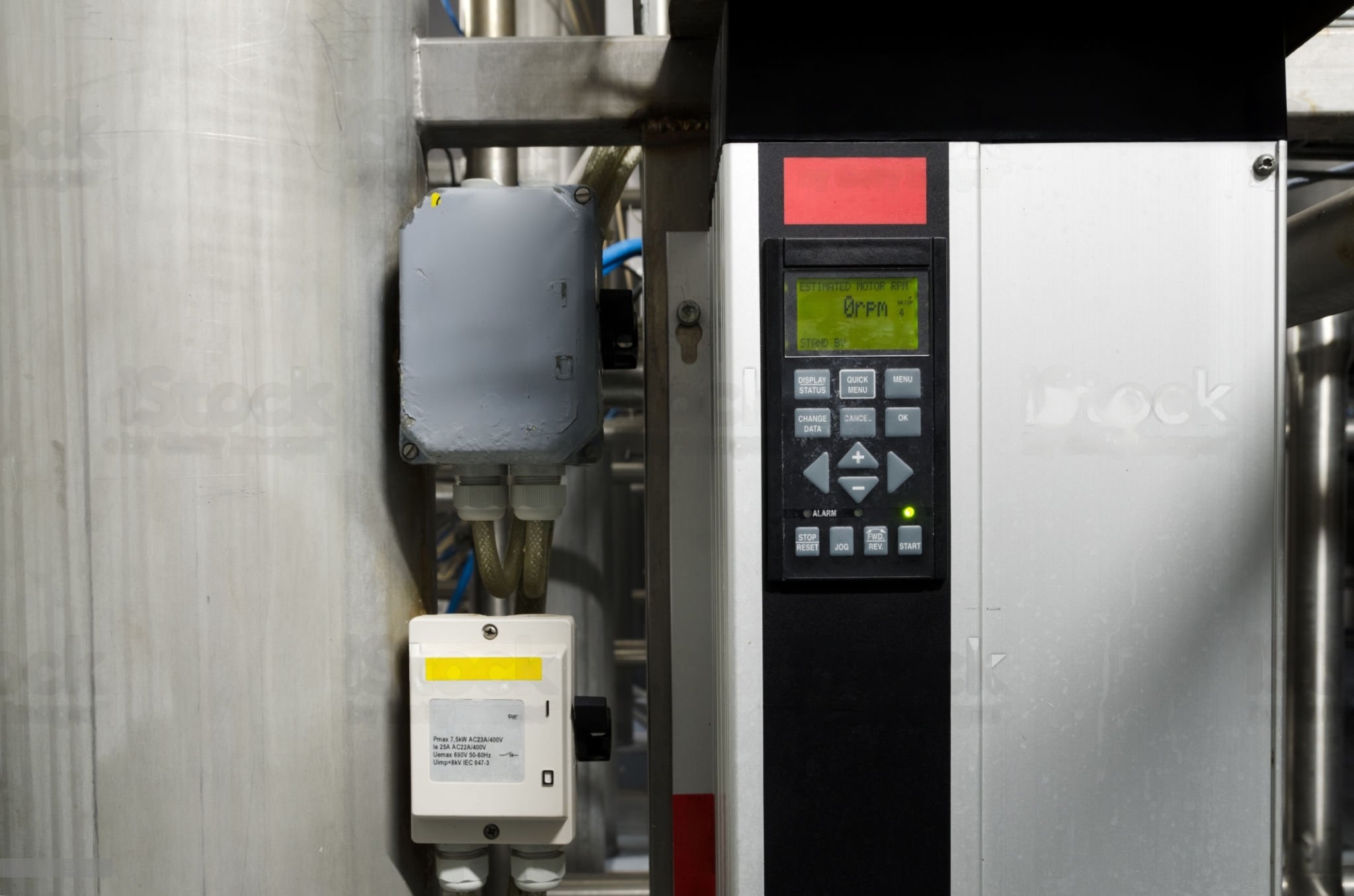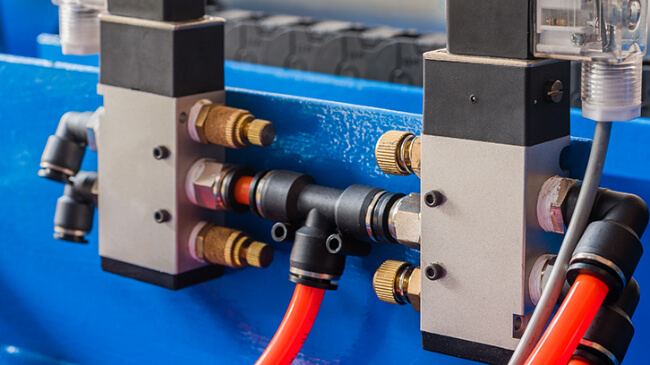A Variable Frequency Drive (VFD), also known as an adjustable speed drive, adjustable frequency drive, AC drive, microdrive, or inverter, is a motor control device that varies the frequency and voltage of the electrical power supplied to an electric motor. By adjusting the motor speed, VFDs offer improved energy efficiency, process control, and reduced mechanical stress on machines. In this comprehensive guide, we will discuss the various aspects of VFDs, including their operation, benefits, applications, and more.
Basic Principles of VFD Operation
A variable frequency drive (VFD) operates by converting the input AC power supply into a variable frequency and voltage output to control the speed of an electric motor. The primary components of a VFD include:
- AC Motor: Typically a three-phase induction motor, designed for fixed-speed operation, and rated for inverter-fed duty according to standards such as NEMA MG-1.
- Controller: A solid-state power electronics conversion system, consisting of a rectifier bridge converter, a DC link, and an inverter. Most drives use voltage-source inverter (VSI) technology with pulse-width modulation (PWM) voltage output.
- Operator Interface: Provides a means for the operator to start and stop the motor, adjust the operating speed, and monitor the VFD’s performance. This interface can be a keypad and display unit mounted on the front of the VFD or connected remotely via a communication protocol such as Modbus or EtherNet/IP.
How VFDs Work
Variable frequency drives control the motor’s speed by adjusting the frequency of the input power. The relationship between motor speed (N), frequency (f), and the number of motor poles (p) is given by the formula:
N = 120 x f / p
By varying the frequency, the VFD can change the motor’s speed, allowing for precise control of processes and improved energy efficiency.
Types of VFDs and Topologies
There are several types of variable frequency drives, each with its own topology and characteristics. Some of the most common VFD types include:
- Voltage-Source Inverter (VSI) Drives: These drives use a capacitor in the DC link to provide a stiff voltage input to the inverter. VSI drives are the most common type, offering higher power factor and lower harmonic distortion than other types of drives.
- Current-Source Inverter (CSI) Drives: These drives use an inductor in the DC link to provide a stiff current input to the inverter, offering good performance in high-torque applications.
- Six-Step Inverter Drives: These drives, now largely obsolete, use a quasi-sinusoidal, six-step voltage or current output for motor control.
- Load-Commutated Inverter (LCI) Drives: Used in high-power applications, LCI drives use a combination of SCR-bridge converters and over-excited synchronous machines to provide adjustable speed control.
Control Platforms and Techniques
Several control platforms and techniques are used to provide precise control of motor speed and torque in VFDs:
- Volts-per-Hertz (V/Hz) Control: This control method adjusts the motor voltage and frequency in a linear relationship, providing adequate performance for most applications. However, it may not be suitable for high-performance applications with demanding speed regulation or positioning requirements.
- Vector Control: Also known as field-oriented control, this method adjusts the motor voltage, angle, and frequency to precisely control the motor’s magnetic flux and mechanical torque. Vector control provides better performance than V/Hz control, especially in low-speed or dynamic applications.
- Direct Torque Control (DTC): This method provides even more precise control of motor torque and flux, allowing for rapid response to changes in load conditions and improved overall performance.
Motor Compatibility with VFDs
VFDs can be used with a variety of electric motor types, including:
- Three-Phase Induction Motors: These are the most commonly used motors with VFDs, as they offer good performance and efficiency at an affordable cost. Induction motors designed for inverter-fed duty (such as NEMA MG-1) can withstand the high-frequency voltage and current stresses imposed by VFDs.
- Synchronous Motors: These motors can also be used with VFDs, but may require special design considerations due to the constant magnet flux linkage in the motor.
- Single-Phase Motors: Some VFDs can be used with single-phase motors, but three-phase motors are generally preferred for better performance and efficiency.
Energy Savings and Efficiency
One of the primary benefits of using a variable frequency drive is the potential for significant energy savings. By adjusting motor speed to match the requirements of the application, VFDs can reduce energy consumption by 10 to 50%. This is particularly important as electrical motors account for an estimated 60-65% of total electrical energy consumption in industrial applications.
The energy savings provided by VFDs are most pronounced in variable-torque centrifugal fan, pump, and blower applications, where the torque and power requirements vary with the square and cube, respectively, of the motor speed. By reducing motor speed, the power required can be significantly reduced, leading to substantial energy savings.
For example, operating a motor at 80% of its rated speed can result in energy consumption of only 51.2% of its full-speed power requirement, translating to significant cost savings over time.
VFD Control and Programming
VFDs can be controlled and programmed in various ways, including:
- Dedicated Programming Software: Some VFD manufacturers provide software for configuring and monitoring the drive’s operation.
- Internal Keypad: Many VFDs include a keypad and display on the front of the drive, allowing for on-site configuration and monitoring.
- External Keypad: In some cases, the keypad and display can be connected to the drive via a cable, allowing for remote configuration and monitoring.
Typical VFD parameters that need to be set include motor nameplate information, speed reference source, on/off control source, and braking control. The VFD may also provide diagnostic information, such as fault codes and input signal states.
Application Considerations
When selecting a VFD for a particular application, several factors should be considered, including:
- Motor Type and Power Rating: The VFD should be compatible with the motor type (induction, synchronous, etc.) and have a sufficient power rating to handle the motor’s requirements.
- Control Requirements: Consider the level of control needed for your application, such as precise speed or torque control, and select a VFD with the appropriate control platform (V/Hz, vector control, DTC, etc.).
- Load Characteristics: Assess the load torque and power characteristics of your application (variable torque, constant torque, constant power), and select a VFD that can handle these requirements.
- Environmental Conditions: Ensure the VFD is suitable for the operating environment, such as temperature, humidity, and dust levels. Higher enclosure ratings (IP20, IP65, etc.) may be necessary for harsh environments.
Harmonics and Noise Reduction
VFDs can generate harmonics and noise in the electrical system, which can interfere with other equipment and reduce overall power quality. To mitigate these issues:
- Use Good Cabling and Grounding Practices: Utilize shielded, symmetrical-geometry power cables to supply the motor and ensure proper grounding of motor stators and other equipment.
- Install Harmonic Filters: Employ passive or active filters to reduce harmonic distortion on the AC power supply.
- Adjust Switching Frequency: Reducing the VFD’s switching frequency can help minimize high-frequency noise and harmonic distortion, although at the expense of increased heat generation in the drive.
Regenerative Drives and Braking
In some applications, regenerative drives can be used to recover braking energy and return it to the power system, improving overall efficiency. Regenerative drives are particularly useful in applications that require frequent braking and starting or in situations where the recovered energy can offset the additional cost of a regenerative system.
Dynamic braking can also be used to slow down a motor, with the braking energy dissipated as heat in a set of resistors. While this method wastes braking energy, it can be a simpler and more cost-effective solution for some applications.
VFD Maintenance and Troubleshooting
Proper maintenance and troubleshooting of VFDs can help ensure reliable operation and extend the life of the drive and motor. Some key maintenance and troubleshooting tips include:
- Inspect and Clean: Regularly inspect the VFD for signs of wear or damage, and clean the drive’s cooling fans and heat sinks to ensure proper heat dissipation.
- Check Connections: Ensure all electrical connections are secure and free from corrosion or damage.
- Monitor Fault Codes and Alarms: Use the VFD’s diagnostic information to identify potential issues and address them promptly.
By understanding the principles of variable frequency drive (VFD) operation, selecting the appropriate VFD for your application, and following proper installation and maintenance practices, you can optimize the performance of your electrical motor systems, improve process control, and achieve significant energy savings.


